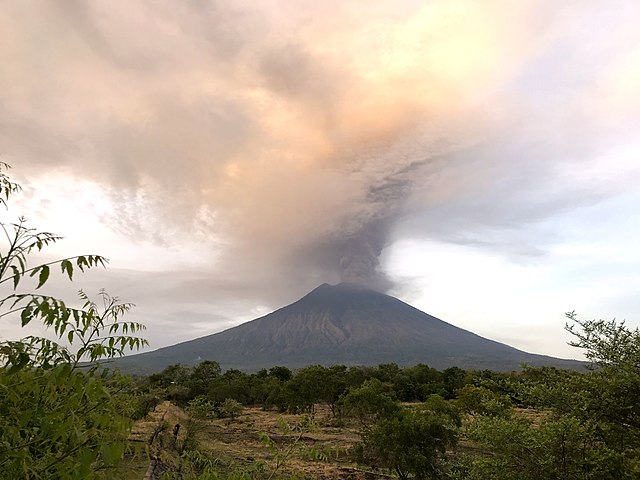
KARANGASEM, Indonesia — A volcano with a deadly history on Indonesia’s Bali, one of the world’s most popular resort islands, has spewed ash 7,600 metres (4.7 miles) high and closed the island’s international airport for a third day Wednesday.
Authorities have told 100,000 people to leave an area extending 10 kilometres (6 miles) from Mount Agung as it belches grey and white ash plumes, the low clouds hanging over the volcano at times hued red from the lava welling in the crater. The volcano’s last major eruption in 1963 killed about 1,100 people, but it’s unclear how bad the current eruption might get or how long it could last.
Officials extended the closure of Bali’s international airport for another 24 hours due to concerns the thick volcanic ash could harm aircraft.
Airport spokesman Ari Ahsanurrohim said more than 440 flights were cancelled Tuesday, affecting nearly 60,000 passengers, about the same as Monday. The closure was in effect until Thursday morning. Without aircraft, getting in or out of Bali requires travelling hours by land and taking a boat to another island, enduring choppy seas in Bali’s rainy season.
Ahsanurrohim said Wednesday morning that volcanic ash has not been detected at the airport yet, but observations from the Darwin Volcanic Ash Advisory Center show the ash has reached an altitude of 25,000 feet (7,600 metres) and was being blown southward and southwestward toward the airport.
“I don’t know, we can’t change it,” said stranded German traveller Gina Camp, who planned to go back outside and enjoy another day on the island, which attracts about 5 million visitors a year to its famed resorts and world-class surf spots. “It’s nature and we have to wait until it’s over.”
Experts said a larger, explosive eruption is possible or Agung could stay at its current level of activity for weeks.
“If it got much worse, it would be really hard to think of. You’ve got a huge population centre, nearly a million people in Denpasar and surroundings, and it’s very difficult to envision moving those people further away,” said Richard Arculus, a volcano expert at Australian National University, adding that an eruption in 1843 was even more explosive than the one in 1963.
“There are many examples in history where you have this kind of seismic buildup — steam ejections of a little bit of ash, growing eruptions of ash to a full-scale stratosphere-reaching column of ash, which can presage a major volcanic event,” he said.
A NASA satellite detected a thermal anomaly at the crater, said senior Indonesian volcanologist Gede Swantika. That means a pathway from the storage chamber in the volcano’s crust has opened, giving magma easier access to the surface.
Indonesian officials first raised the highest alert two months ago when a rash of seismic activity was detected at the mountain. More than 100,000 people living near the volcano fled their homes, many abandoning their livestock or selling them for a fraction of the normal price. The seismic activity decreased by the end of October, causing authorities to lower the alert level.
Tremors increased again last week and officials upped the alert and ordered another large-scale evacuation, with nearly 40,000 people now staying in 225 shelters, according to the Disaster Mitigation Agency in Karangasem. But tens of thousands of villagers have remained in their homes because they feel safe or don’t want to abandon their farms and livestock.
“Ash has covered my house on the floor, walls, banana trees outside, everywhere” said Wayan Lanus, who fled his village in Buana Giri with his wife and daughter.
Flows of volcanic mud have been spotted on Agung’s slopes, and Arculus warned more are possible since it’s the rainy season.
“They’re not making a lot of noise. It’s just suddenly coming like a flash flood out of nowhere,” he said. “You do not want to be near them. Stay out of the valleys.”
Indonesia sits on the Pacific “Ring of Fire” and has more than 120 active volcanoes.
——
Mason reported from Jakarta. Associated Press writer Ali Kotarumalos in Jakarta contributed to this report.